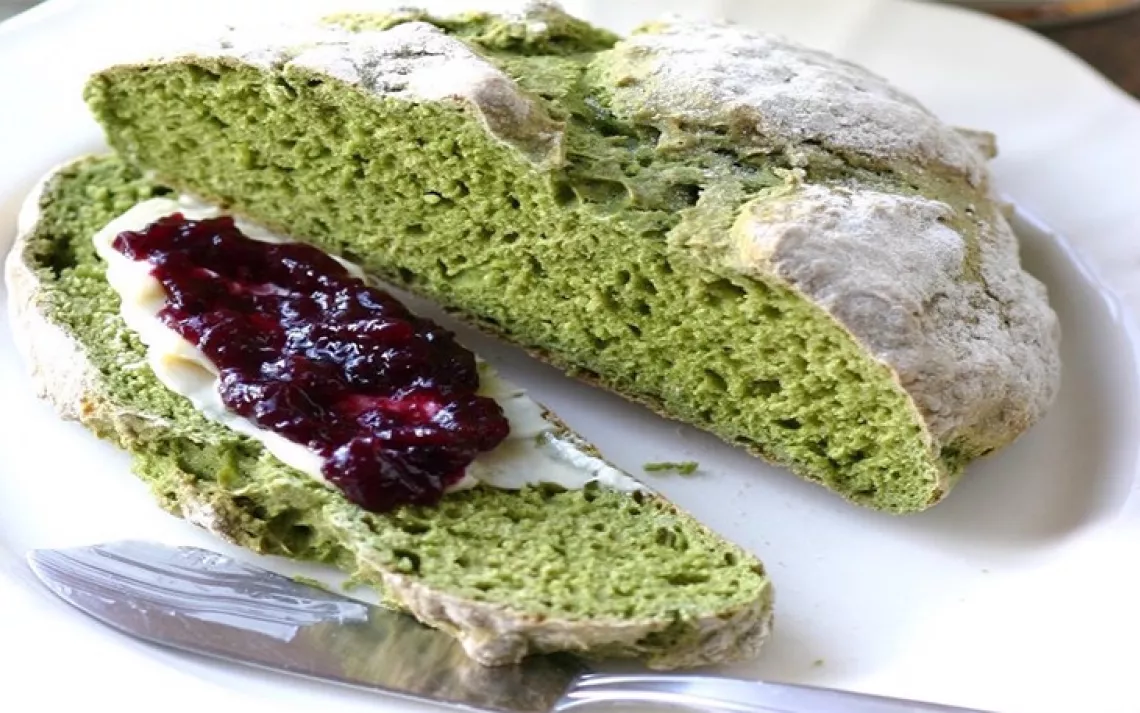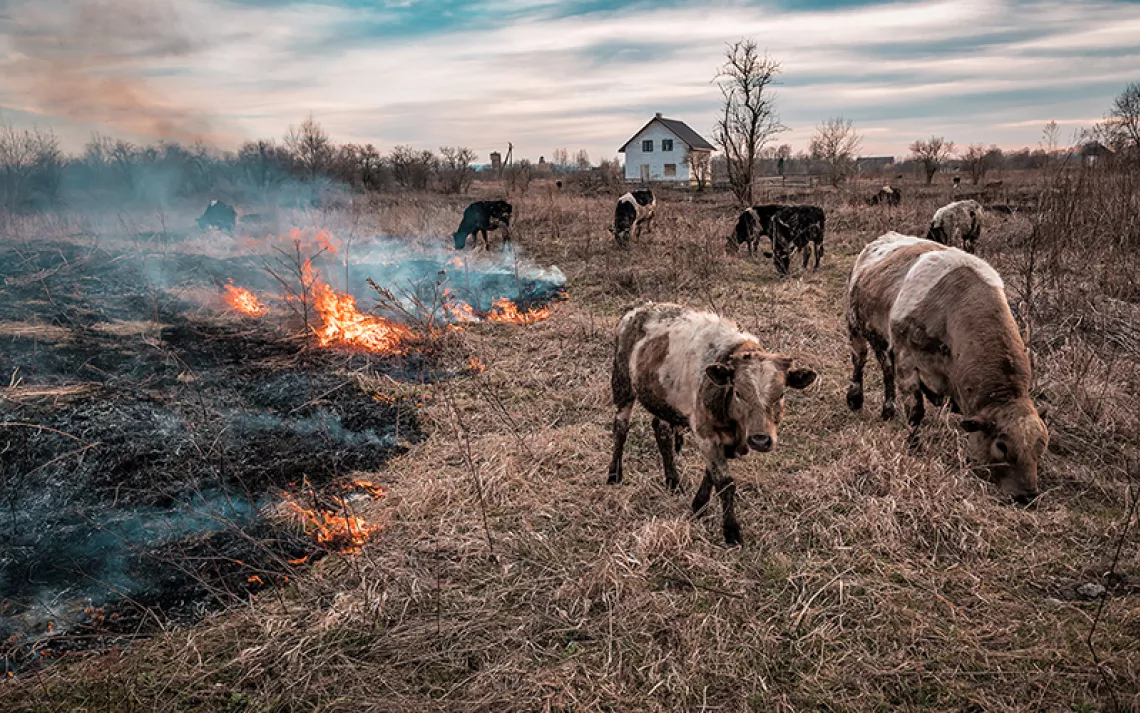4 Lunar New Year Dishes With a Vegan Twist
Celebrate the holiday with traditional foods that are good for the environment
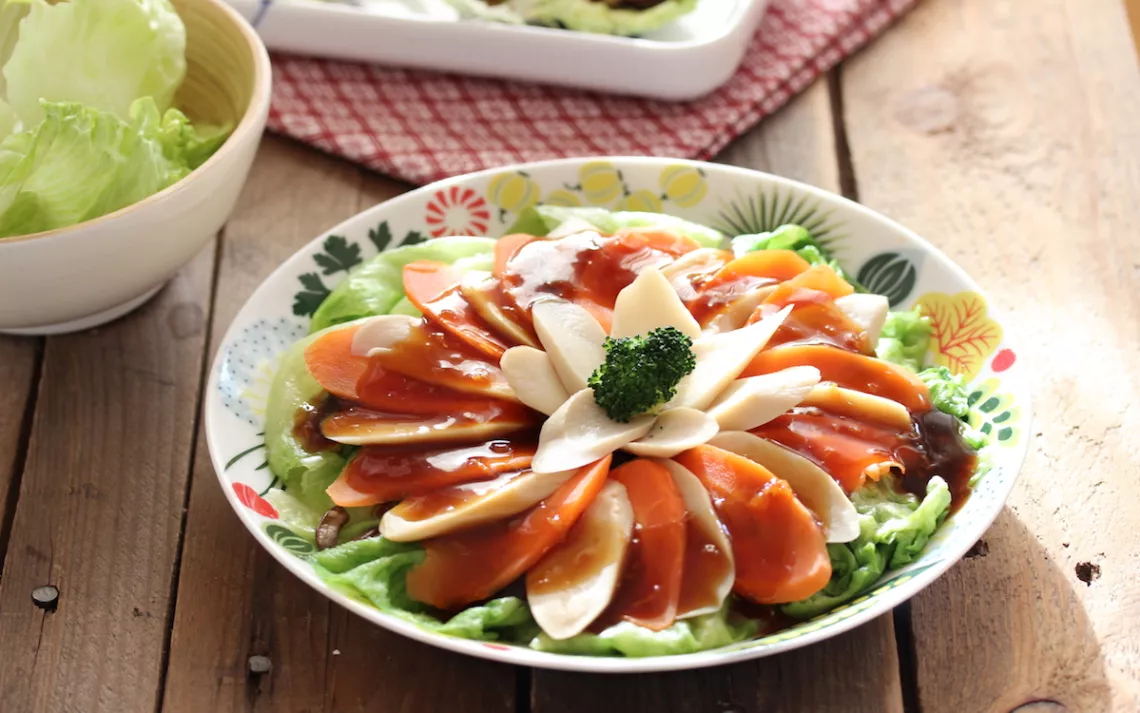
Photo by Lorina
Lunar New Year, or the Spring Festival, is a time for families all over the world to get together and usher in a brand-new year. At least 2 billion people in China, Singapore, Taiwan, Korea, and Malaysia celebrate the holiday, as do immigrant communities in countless other countries. The holiday is a chance to wish each other good fortune and good health, but—let’s face it—it’s also an excuse to eat as much as we want without judgment, and to have delicious leftovers for breakfast, lunch, and dinner the rest of the week.
The celebratory foods associated with the New Year are often meat-heavy, which makes the holiday not so environmentally friendly—at least 50 percent of global greenhouse gas emissions come from animal agriculture, according to the Worldwatch Institute. In Asia, meat consumption has significantly increased along with the region’s rapidly growing population. The projected growth for East Asia and the Pacific’s demand for beef alone from 2000 to 2030 is an increase of a staggering 8,798 tonnes, or 130 percent. Despite these numbers, there is still a deep-rooted tradition of vegan and vegetarian cuisine in many Asian cultures, so why not take it upon ourselves to prepare a hearty New Year’s meal that is as environmentally friendly as it is delicious?
We’ve picked (and translated into English) four Chinese New Year dishes from vegan Taiwanese chefs that signify good tidings and are easy to make. You can find the condiments and vegetables at your local Asian supermarket.
Oyster Mushroom and Carrot Salad
This recipe from Taiwanese blogger Lorina—who goes by her first name—is a simple dish to ease first-timers into the somewhat chaotic New Year's feast preparation, in which people make six, eight, or 10 dishes because these numbers are auspicious in many Asian cultures. The salad is plated to resemble a blooming flower—flowers bloom in spring, and the Chinese believe that they bring wealth—and can be served hot or cold.
This recipe serves four. You’ll need:
2 whole oyster mushrooms, diagonally sliced
1 medium carrot, diagonally sliced
½ head of iceberg lettuce, leaves separated
3 tbsp of vegan oyster sauce
3 tbsp of mirin or sake
1 tbsp of cornstarch powder
Salt to taste
Boil a pot of water with a dash of salt, and blanch the lettuce leaves for 10 seconds so they are soft but still retain their crunch. Remove the lettuce and boil the sliced mushrooms for 30 seconds to a minute; then do the same with the sliced carrot. Keep the water.
In a clean saucepan, mix the vegan oyster sauce, mirin, the vegetable water, and cornstarch powder to form a sauce for the salad.
Spread the lettuce leaves out on a large plate, and arrange the mushroom and carrot slices in the middle so that the dish resembles a flower in full bloom. Drizzle the sauce over the “flower” and serve.
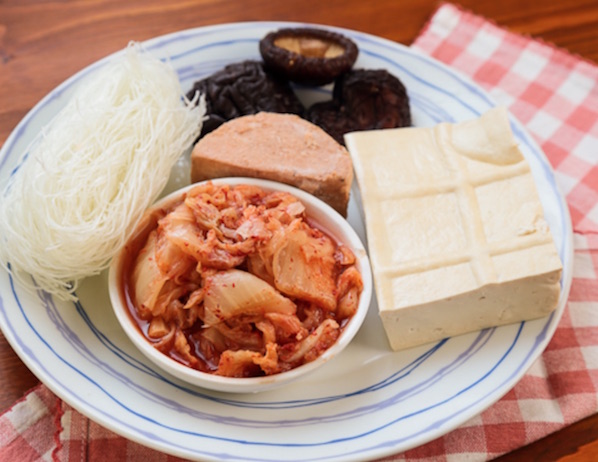 Kimchi Dumplings: A Staple New Year’s Dish With Korean Flair
Kimchi Dumplings: A Staple New Year’s Dish With Korean Flair
Photo by Su Jiang Ma
Dumplings are everyday fare in many Asian countries, but they are often a part of the New Year’s dinner table because of their oblong shape, which resembles silver ingots used as currency in China’s days of yore and are meant to bring wealth in the coming year.
This unusual variation comes from Su Jiang Ma, a stay-at-home mom known in Taiwan’s growing vegetarian community for her creative vegan recipes.
The best thing about these dumplings is you get to decide the ratio of the ingredients and seasonings, and you can taste the filling as you go because it contains no raw meat.
You’ll need:
Round dumpling wrappers (sold at Asian supermarkets in packets of 50 to 100)
2 cups of kimchi
1 box of firm tofu
A handful of vermicelli
1 cup of Tofurky or soy ham
5 whole, dried shiitake mushrooms
Sesame oil
2 tsp of powdered shiitake mushroom
Canola or olive oil, for stir-frying
Soak the shiitake mushrooms for two hours before cooking to soften them. Chop the kimchi, soy ham, and shiitake mushrooms finely. Press the tofu like you would a sponge, to release the moisture, and then mince it. Boil the vermicelli noodles until cooked, run them under cold water for texture, drain, and then chop into shorter strands.
Heat the cooking oil in a wok or a big saucepan, and stir-fry the mushrooms over medium heat for a few minutes; then mix in the soy ham. Transfer the mixture into a large bowl and stir in the chopped kimchi and tofu, adding sesame oil and shiitake powder to season. Taste the mixture and adjust the seasoning according to your preference.
Place a wrapper on the palm of your hand (if you’re a righty, use your left hand to cradle the ingredients and your right to pleat), and scoop a tablespoon of filling onto the middle. Dab a bit of water along the edge of the wrapper. Cup your palm so the wrapper takes the shape of a taco shell, fold the wrapper in half and pinch to seal at the midway point. To the right of the midpoint, fold a small section of the wrapper toward the midpoint, pinch and seal to form a pleat. Repeat on both sides of the midpoint five more times, making sure each dumpling has three pleats on the right and three on the left. (Or, watch this YouTube video to see a slightly different method.)
You can freeze the dumplings for future meals, or cook them right away. Usually people dip dumplings in soy sauce, vinegar and/or chili oil, but in this case, the kimchi packs such a flavor punch that you can forgo additional condiments.
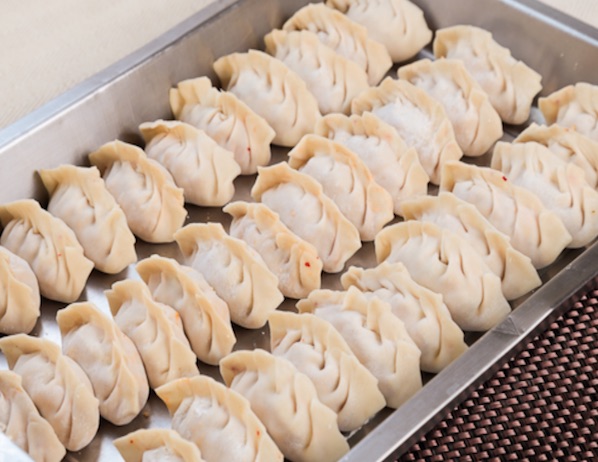 Taro Dumplings: Sweet, Fluffy, and Satisfying
Taro Dumplings: Sweet, Fluffy, and Satisfying
Photo by Su Jiang Ma
This recipe, also by Su Jiang Ma, is for a different kind of dumpling filling if you don’t like kimchi, or in case you want to provide both sweet and savory options for family and friends.
You’ll need:
Round dumpling wrappers
1 or 2 taros
1 cup of sweet corn kernels (canned is fine)
5 or 6 whole, dried shiitake mushrooms
1/2 cup of water chestnuts
2 tbsp of sugar
Canola or olive oil for stir-frying
A small dish of vegan oyster sauce
Peel the taro and grate into long pieces, then steam for five minutes to soften. If you don’t have a steamer, place a small baking rack in a large pot or wok, fill with water, and put a bowl of grated taro on the rack. Put the lid on and steam on high heat.
Mash the steamed taro into a paste, mix in sugar, and set aside to cool.
Stir-fry the shiitake mushrooms over medium heat, then add the corn and water chestnuts and stir for five minutes. Mix the mushroom-corn-chestnut combination into the taro paste. Follow the wrapping and cooking instructions above.
Serve with vegan oyster sauce for a savory-sweet combination.
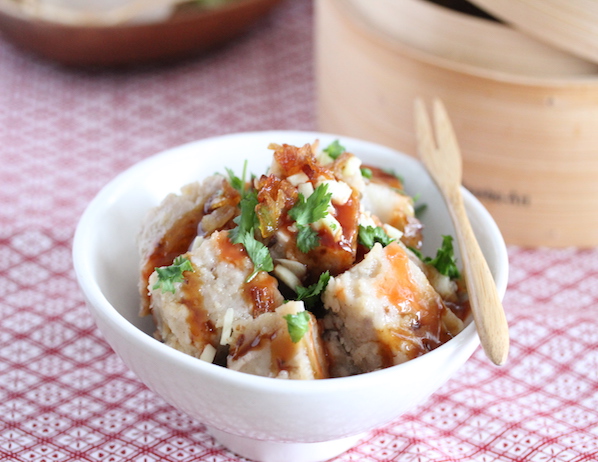 Vegan Daikon Cake
Vegan Daikon Cake
Photo by Lorina
This recipe is also from Lorina. Sweet and savory cakes are almost always a part of Lunar New Year feasts because the word cake is pronounced in Chinese like the word gao, or “high.” Children and adults alike are encouraged to eat traditional New Year’s cakes to reach new heights, get higher grades in school, or score a promotion at work. Daikon cake is the most popular of them all, whether steamed or fried and with a drizzle of your favorite condiment.
This recipe serves six to eight. You’ll need:
1 Chinese daikon radish, peeled and grated into strips
3 cups of rice flour
6 ½ cups of water
1 tsp of ground white pepper
1-1½ tsp of salt (adjust as needed)
Cook grated daikon in a big pot of water until it is soft and translucent, then drain and set aside.
Mix the rice powder, salt, white pepper, and water in a big bowl until sticky, and then mix into the cooked daikon until the pieces of daikon are evenly distributed in the paste. Pour the mixture into a cake mold.
Place the cake mold into a steamer, add one cup of water, and cook on high heat until the water evaporates (about 45 minutes). Let the cake cool, then remove it from the mold and cut into half-inch slices to either eat right away or store in the fridge. You can also pan-fry the sliced daikon cake until both sides are golden brown and serve with a drizzle of soy sauce.
 The Magazine of The Sierra Club
The Magazine of The Sierra Club

